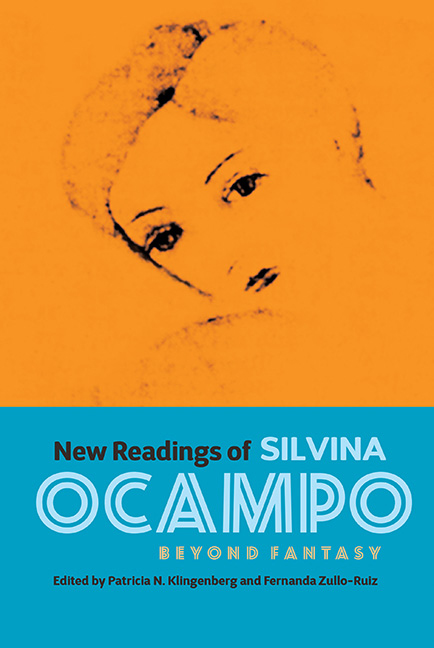Book contents
- Frontmatter
- Contents
- Illustrations
- Contributors
- Acknowledgments
- Introduction: Reading Silvina Ocampo
- 1 Silvina Ocampo for the Twenty-first Century: A Review of Recent Criticism
- 2 Re-reading Autobiografía de Irene: Writing and its Double in the Narrative of Silvina Ocampo
- 3 Sur in the 1960s: Toward a New Critical Sensibility
- 4 Reading Cruelty in Silvina Ocampo's Short Fiction: Theme, Style, and Narrative Resistance
- 5 Eros and its Archetypes in Silvina Ocampo's Later Stories
- 6 In Memory of Silvina Ocampo
- 7 Classical Reference in Silvina Ocampo's Poetry
- 8 Silvina Ocampo and Translation
- 9 The Gender-Bending Mother of “Santa Teodora”
- 10 Illicit Domains: Homage to Silvina Ocampo in Alejandra Pizarnik's Works
- Afterword: Reflections on Silvina Ocampo
- Bibliography
- Index
10 - Illicit Domains: Homage to Silvina Ocampo in Alejandra Pizarnik's Works
Published online by Cambridge University Press: 31 March 2017
- Frontmatter
- Contents
- Illustrations
- Contributors
- Acknowledgments
- Introduction: Reading Silvina Ocampo
- 1 Silvina Ocampo for the Twenty-first Century: A Review of Recent Criticism
- 2 Re-reading Autobiografía de Irene: Writing and its Double in the Narrative of Silvina Ocampo
- 3 Sur in the 1960s: Toward a New Critical Sensibility
- 4 Reading Cruelty in Silvina Ocampo's Short Fiction: Theme, Style, and Narrative Resistance
- 5 Eros and its Archetypes in Silvina Ocampo's Later Stories
- 6 In Memory of Silvina Ocampo
- 7 Classical Reference in Silvina Ocampo's Poetry
- 8 Silvina Ocampo and Translation
- 9 The Gender-Bending Mother of “Santa Teodora”
- 10 Illicit Domains: Homage to Silvina Ocampo in Alejandra Pizarnik's Works
- Afterword: Reflections on Silvina Ocampo
- Bibliography
- Index
Summary
This essay posits the hypothesis that in addition to personal affective ties, which were revealed with the publication of part of their correspondence, there were also strong connections between the works of Alejandra Pizarnik and those of Silvina Ocampo. There are moments when that relationship is made explicit – a review, a title of a poem, a few dedications – but the homage to Ocampo in Pizarnik's work is also a blurry presence in other areas. It is useful to think of La condesa sangrienta not only in relation to Valentine Penrose's book, or to Borges's Historia universal de la infamia – two models that have garnered critical attention – but also to the stories from La furia (1959). It is useful to think of Pizarnik's poetic projects, quite different on the surface from those by Ocampo, in part as an homage to the poetry of her friend and precursor. And it is also useful to think of what Ocampo might represent for Pizarnik in the Argentine literary landscape – her differences from other women writers, the strangeness of her works – as something productive in her own creative processes.
The review Pizarnik wrote in 1967 (which was published the following year in Sur) of El pecado mortal, an anthology of Ocampo's short stories that the publishing house Centro Editor de América Latina distributed with a prologue by José Bianco, is notable because it initiated (with Bianco's text) the serious study of Ocampo. Pizarnik's review, titled “Dominios ilícitos,” speaks of the “extrema concentración” of Ocampo's stories, the “insumisión a los esquemas del relato,” her “reserva delicada” and the use of ambiguity (Pizarnik, Obras completas 252) [extreme concentration … rebellion against the short story schemas … delicate reserve], as well as the “modo de hacer visibles las pasiones infantiles” (253) [manner of making visible infantile passions]. She mentions her delicate humor (255) and her preference for unexpected perspectives:
Como puede comprobarse, la autora no intenta poner en tela de juicio la noción de realidad. Pero, por las dudas, prefiere que los hechos más normales sean transmitidos por “puntos de vista” de la estirpe de la enanita muerta de risa (de “El vestido de terciopelo”). (254)
- Type
- Chapter
- Information
- New Readings of Silvina OcampoBeyond Fantasy, pp. 211 - 220Publisher: Boydell & BrewerPrint publication year: 2016

